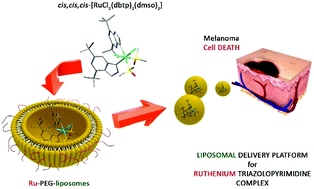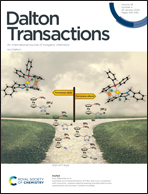Nanoencapsulation of a ruthenium(ii) complex with triazolopyrimidine in liposomes as a tool for improving its anticancer activity against melanoma cell lines†
Abstract
Two types of ruthenium(II) complexes containing 1,2,4-triazolo[1,5-a]pyrimidines of the general formulas [RuCl2(dmso)3(L)] ((1)–(3)) and [RuCl2(dmso)2(L)2] ((4)–(6)), where L represents 1,2,4-triazolo[1,5-a]pyrimidine (tp for (1)), 5,7-dimethyl-1,2,4-triazolo[1,5-a]pyrimidine (dmtp for (2)), 7-isobutyl-5-methyl-1,2,4-trizolo[1,5-a]pyrimidine (ibmtp for (3)), 5,7-diethyl-1,2,4-triazolo[1,5-a]pyrimidine (detp for (4)), 5,7-ditertbutyl-1,2,4-triazolo[1,5-a]pyrimidine (dbtp for (5)) and 5,7-diphenyl-1,2,4-triazolo[1,5-a]pyrimidine (dptp for (6)), have been synthesized and characterized by elemental analysis, infrared, multinuclear magnetic resonance spectroscopic techniques (1H, 13C, and 15N), and X-ray (for (3), (4), and (5)). All these complexes have been thoroughly screened for their in vitro cytotoxicity against melanoma cell lines A375 and Hs294T, indicating cis,cis,cis-[RuCl2(dbtp)2(dmso)2] (5) as the most active representative, in addition to being non-toxic to normal human fibroblasts (NHDF) and not inducing hemolysis of human erythrocytes. In order to develop an intravenous formulation for (5), liposomes composed of soybean phosphatidylcholine (SPC), cholesterol (Chol) and 1,2-distearoyl-sn-glycero-3-phosphoethanolamine-N-[amino(polyethylene glycol)-2000] (DSPE-PEG2000) were prepared and subsequently characterized. (5)-Loaded liposomes, with spherical morphology, assessed by transmission electron microscope (TEM), exhibited satisfactory encapsulation efficiency and stability. In in vitro experiments, PEG-modified (5)-loaded liposomes were more effective (10-fold) than free (5) for growth inhibition of both human melanoma cell lines. Furthermore, such an approach resulted in the reduction of cancer cell viability that was even 10-fold greater than that observed for free cisplatin.



 Please wait while we load your content...
Please wait while we load your content...